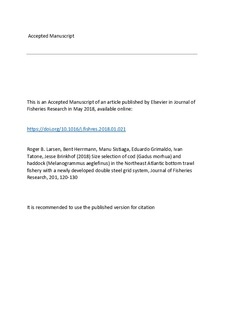| dc.contributor.author | Larsen, Roger B. | |
| dc.contributor.author | Herrmann, Bent | |
| dc.contributor.author | Sistiaga, Manu Berrondo | |
| dc.contributor.author | Grimaldo, Eduardo | |
| dc.contributor.author | Tatone, Ivan | |
| dc.contributor.author | Brinkhof, Jesse | |
| dc.date.accessioned | 2019-04-25T08:08:24Z | |
| dc.date.available | 2019-04-25T08:08:24Z | |
| dc.date.created | 2018-10-08T13:08:16Z | |
| dc.date.issued | 2018-05 | |
| dc.identifier.citation | Fisheries Research. 2018, 201 120-130. | nb_NO |
| dc.identifier.issn | 0165-7836 | |
| dc.identifier.uri | http://hdl.handle.net/11250/2595388 | |
| dc.description.abstract | In recent years, Norwegian fishermen have reported problems with fish accumulation in front of the mandatory sorting grids (Sort-X, Sort-V, and Flexigrid). These problems are associated with high fish entry rates and low water flow through the grid sections. In this study, we replaced the lifting panel in the original design of a sorting grid section (Sort-V) by another steel grid (“lower grid”) in order to improve water flow and increase sorting area. Two different inclination angles of this new additional “lower grid” were tested. The results demonstrated that both the lower grid and the main grid contributed to the release of cod and haddock. However, the release efficiency of the lower grid was low compared to that of the main grid. A larger proportion of fish contacted at least one of the grids with the lower grid set at 40° compared to at 35°. The new double grid was found to release significantly more haddock between 38 and 50 cm long than the mandatory Flexigrid. For cod, the sorting system was at least as good as the Flexigrid at releasing undersized fish. Thus, the new double grid system represents a potential alternative to the Flexigrid. Although the Sort-V single grid releases significantly more undersized cod and haddock than the new double grid system, it also releases a significantly higher proportion of the targeted commercial sizes. | nb_NO |
| dc.language.iso | eng | nb_NO |
| dc.rights | Attribution-NonCommercial-NoDerivatives 4.0 Internasjonal | * |
| dc.rights.uri | http://creativecommons.org/licenses/by-nc-nd/4.0/deed.no | * |
| dc.subject | Sorting grid | nb_NO |
| dc.subject | Selectivity | nb_NO |
| dc.subject | Trawl | nb_NO |
| dc.subject | Cod | nb_NO |
| dc.subject | Haddock | nb_NO |
| dc.subject | Water flow | nb_NO |
| dc.title | Size selection of cod (Gadus morhua) and haddock (Melanogrammus aeglefinus) in the Northeast Atlantic bottom trawl fishery with a newly developed double steel grid system | nb_NO |
| dc.type | Journal article | nb_NO |
| dc.type | Peer reviewed | nb_NO |
| dc.description.version | acceptedVersion | nb_NO |
| dc.source.pagenumber | 120-130 | nb_NO |
| dc.source.volume | 201 | nb_NO |
| dc.source.journal | Fisheries Research | nb_NO |
| dc.identifier.doi | 10.1016/j.fishres.2018.01.021 | |
| dc.identifier.cristin | 1618687 | |
| dc.relation.project | Norges forskningsråd: 243627 | nb_NO |
| cristin.unitcode | 7566,2,0,0 | |
| cristin.unitname | Sjømatteknologi | |
| cristin.ispublished | true | |
| cristin.fulltext | postprint | |
| cristin.qualitycode | 1 | |

